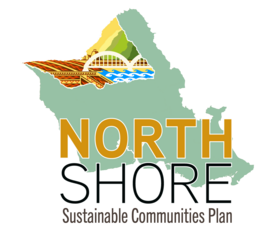Do you agree with the following vision element?
"Adapt the Ahupua'a Concept as a Framework for Land Use and Natural Resource Management"
View the 2011 NSSCP description of this vision element below:
Traditional Hawaiian life was based on the ahupua‘a system of land management. An ahupua‘a, or land division, was typically wedge-shaped and extended from the top of the mountain into the outer edge of the ocean reef. Defined by the natural geographic formations such as mountain ridges, gulches and streams, ahupua‘a were complete ecological and economic production systems that provided all the resources to sustain the community living within the ahupua‘a. Fish and marine resources were harvested from the ocean, kalo (taro) and ‘uala (sweet potato) were raised in the lowlands, and upland areas provided trees and other forest products.
The mokupuni, or island, of O‘ahu is made up of six moku, or districts. There are two moku in the North Shore Sustainable Communities Plan area – the entire moku of Waialua and a portion of Ko‘olau Loa. Waialua, the northwestern moku, extends from Ka‘ena Point in the west to Kapaeloa at Waimea in the east. Ko‘olau Loa is the northeastern moku that stretches from Waimea Bay to Ka‘a‘awa. The eighteen ahupua‘a in the North Shore Sustainable Communities Plan area include: Ka‘ena, Keālia, Kawaihāpai, Kikahi, Auku‘u, Mokulēi‘a, Kamananui, Pa‘ala‘a, Kawailoa, Lauhulu, Kuikuiloloa, Punanue, Kāpaeloa, Waimea, Pūpūkea, Paumalū, Kaunala and a portion of Waiale‘e. While the communities in the various ahupua‘a may be diverse, they share a common desire to preserve the natural, cultural and historical heritage of the region.
The ahupua‘a concept is a holistic approach to land management that recognizes the connections between land-based and marine-based natural resources and the dependent relationships between ecological functions. Resources were managed for the collective good of all living within the ahupua‘a, based on the principle that activities in one part of the ahupua‘a affected all other parts (for example, inappropriate management of forestry and agricultural uses in the upland areas can negatively affect the quality of streams and coastal waters). Adapted to the context of today’s community needs and technology, the ahupua’a concept provides useful principles for guiding the use and management of the North Shore’s resources. The application of these traditional values to current land use activities and environmental regulatory and management practices promotes effective management of the North Shore’s natural resources and deters land-based activities which contribute to their degradation. In keeping with this approach, the planning and implementation of land use decisions and land-based actions considers related effects on coastal waters and the nearshore environment. Moreover, all development and infrastructure improvement decisions recognize that the changes to one segment of the community will have consequences that extend beyond that particular action. Utilizing this approach, a relatively minor project involving a small segment of land or a short stretch of roadway could have significant implications on other parts of the community when the various systems that make up the community are considered as a whole. On a broader scale, there is a need to recognize the connection between the North Shore and its neighboring regions (i.e., Central O‘ahu, Ko‘olau Loa and Wai‘anae), and the many ways that events and activities occurring in one region may affect the others.
